Alifa Muneerudeen , Fadi Al Khani , Raffaello Furlan
College of Engineering Department of Architecture and Urban Planning, Qatar University, Doha, Qatar
Correspondence to: Raffaello Furlan , College of Engineering Department of Architecture and Urban Planning, Qatar University, Doha, Qatar.
| Email: |  |
Copyright © 2016 Scientific & Academic Publishing. All Rights Reserved.
This work is licensed under the Creative Commons Attribution International License (CC BY).
http://creativecommons.org/licenses/by/4.0/

Abstract
Qatar has witnessed a rapid development in urbanism within the last few decades especially after the oil discovery. Modern style projects have been imported to the country in-order to reflect aluxurious image. The Fareej (traditional Gulf) neighbourhood has almost disappeared and a modern lifestyle has replaced it. The Pearl Island in Qatar was one of these luxury projects contributing to the new impression. However, its social spaces lack social interaction, cohesion and vibrancy; thus, the space is less attractive except to a select group of people. Visitors are quick to notice the absence of social activities in the area, which reduces the liveability of the place. This paper focuses on investigating the social spaces of Pearl, Qatar to provide insight into what is missing and how the space could be revitalized to improve the quality of the space for users. Some recommendations are suggested to serve this aim. The paper in conclusion notes that the usage of the space can be optimised through various interventions such as hosting festivals and events in the open areas. Measures to improve thermal comfort including shading devices and thermally suited seating as well as limiting vehicular access would also help achieve the goal.
Keywords:
Social spaces, Liveability, Urban revitalization, Urban Sociology, Social interaction, Cohesive social spaces
Cite this paper: Alifa Muneerudeen , Fadi Al Khani , Raffaello Furlan , Urban Revitalization of Public Spaces in the Pearl in Qatar, American Journal of Sociological Research, Vol. 6 No. 1, 2016, pp. 1-9. doi: 10.5923/j.sociology.20160601.01.
1. Introduction
Qatar is a peninsula located in the eastern side of the Arabian Peninsula, bordering the Arabian Gulf and Saudi Arabia. It has a hot climate in summer with high temperatures that could reach 46°C and warm winter with average rainfall of 75.2 mm per year. Doha is the capital city and it is the main hub for commercial and financial institutes. The population has increased dramatically and the latest survey in December 2014 reported to the population to be 2,347,000. Qatar has made its mark on the world with various mega events staged to take place, particularly the FIFA 2022 world cup. The Pearl Qatar is a man-made island situated where one of Qatar's major pearl diving sites once stood, hence its name. It is physically connected to the mainland by a four lanes causeway and is about 12.5 miles from Doha’s International Airport. The Pearl is planned as a four-phase mixed use development comprising 10 distinct districts housing 8,000 beachfront villas, elegant town houses, luxury apartments & exclusive penthouses. It is further well known for 5 star hotels, marinas, schools as well as retail places & restaurants. It is the first of Qatar’s land to be available for freehold ownership by foreign nationals. The First investors took up residency in 2009, as of January 2015 and there are 12,000 residents.The Pearl was designed and built in collaboration with United Development Company (UDC), where Qatari shareholders own 75 percent of the Company’s total shares while the remaining 25 percent are held by international investors. It was designed by Callison, an international architecture firm based in Seattle, Washington.The Pearl, once completed in 2018, will resemble a string of pearls and will have created over 32 kilometres of new coastline for use as a residential estate with an expected 18,831 dwellings and 45,000 residents. The Pearl represents a prestigious up-scale, multi-cultural residential community living, unrivalled in quality, and a unique Riviera atmosphere, on a secure and exclusive island. Along the shores facing north and east, relatively long pocket beaches have been introduced. Terraced beaches have been used where the wave impact is oblique and also where an open beach would erode.The Pearl-Qatar is a multi-billion dollar offshore, man-made island, covering 985 acres of reclaimed land. Residential development on the island is intended to incorporate various national and international themes, including aspects of Arabic, Mediterranean, and European styles. The residential properties are available for purchase or lease whether it be for short term getaways, long-term vacations or permanent residencies. The study will be focused on the Porto Arabia precinct of the Pearl as the public space to be investigated (Figure-1, 2). The Riviera Arabia consists of Mediterranean style towers, townhouses, hotels, retail and commercial spaces, 2.5 kilometre of corniche and 785-berth marina and other apartments. Porto Arabia combines elegant towers and townhouses in a spectacular location. The Island’s first phase is set around a colourful waterfront (La Croisette) with a lively 2.5 kilometres pedestrianized concourse, lined with public spaces for high class shopping and dining around the 400-boat slip marina. The architecture for all of this is inspired by the best French, Italian and Spanish designs. The marina’s edge offers superb views which attract most visitors to have lunch or dinner and at least a cup of coffee in the cafes there. The beautiful landscapeat the Pearl is unique in Qatar, and is a new feature, being considered a special point of interest in Doha. The celebratory hub of Porto Arabia is RasCroisette, which has a unique atmosphere with night restaurants and lounges. They, along with Marsa Arabia Island’s picturesque hotel attract a specific category of visitors, mainly business and leisure travellers. Porto Arabia is a replica of the Mediterranean Riviera regardless of the climatic and cultural aspects. But these factors form the very basis for any public space to be inhabited. | Figure 1. The Pearl, source: www.thepearl.com |
 | Figure 2. Porto Arabia location within the Pearl, source: www.thepearl.com |
2. Background
Public spaces, social life and socio-cultural valuesPublic spaces such as town squares, cafés, restaurants, markets, parks etc. are social places that act as a gathering area for people to interact. People from varied cultures and backgrounds ideally exist in harmony with each other and the surroundings, thus unifying and bringing life to the space. Well-designed public spaces will spring to life with people forming memories and associations with the place and would encourage social interactions and exchanges between humans. Mixed use developments such as the Pearl could be more attractive if its social life was revitalized. Gulf countries post the oil boom became a fertile ground for people of various backgrounds to work and spend a considerable portion of their lives in.Arabs in the Middle East generally form close knit communities with tight family and religious values. Social relations and interpersonal communications often involve physical touch. Traditionally the Arab spaces of socialization are segregated based on gender, age and other issues. As globalization and exchange of ideas became more common, the Islamic concepts of unity, harmony and continuity have been replaced by ‘western way’ in terms of development. For example, the majority of the new buildings in Middle Eastern cities are designed for another culture and they end up creating an alien environment within Islamic communities (Furan R, 2015).A secondary social space thus came into being- a space that is shared between natives and non-natives from all over the world. This is a more democratic space which is not segregated by race, gender, social or religious affiliations.Due to the increasing demand for such spaces, projects such as Souk Waqif, which is also a remodelled souk, and at the other end of the spectrum, mixed use developments such as the Pearl, have sprung up. These spaces cater to a generic crowd and thus are not as affected by the traditional values in the country. People are accommodated and accepted into these spaces provided they are modest in behaviour and dress code.New Urbanism and liveability New urbanism (or mixed use traditional neighbourhood development) emerged from discontent with the trend of suburbs and associated shopping mall culture (Furriest, 1997). New urbanism is Howard’s concept of the Garden City repackaged and marketed as the solution to urban problems such as insecurity, alienation, urban decay and inadequate transport infrastructure. (Dear, 2000). Designing great places for the comfort and enjoyment of the pedestrian is one of the most important aspects of New Urbanism. The finest places in the world are cities with entire networks of car-free streets, known as pedestrian cities. Managing growth, reducing traffic, creating sustainable development, and making smart transportation investments are all challenges we face today. New Urbanism is a development strategy that addresses these issues and more by creating communities that are liveable, walkable, & sustainable, while raising the quality of life. A “lively urban space” is an urban space where the presence of a significant number of people and their diversity (in terms of age and gender) is possible in the vast expanse of time in a day during which their activities are mainly seen in the form of social choice.Planners find that the way of life can be influenced by spatial environments. A Liveable community is one that offers choice and diversity in the range of amenities available to people who live and work in the community. Liveability interventions can increase the potential for longer - term strides toward sustainability (Gough, 2015).Liveability can be enhanced by more opportunity in all aspects of life, for instance shaded walkways and pavements increase walkability and social presence which can contribute to community engagement. Analysis of human behaviour and/or activities can provide better understanding of how the built environment should be shaped in response to its users’ specific needs (Furlan R, 2015).Urban SociologyThis discipline deals with human interaction within the place and affects the built environment and human behaviour at social, economic, and cultural levels. The physical environment is a main element affecting human life, perception and description of space. Open public spaces are seen as a motive for political action, civic engagement and democratic practices (Shin, Y. J, 2009).Social spaces that are walkable provide more meaning to the public realm. The Corniche has been the main social hub in the city for a long time but lacks any sort of amenities in its vicinity. Thus recently constructed Public spaces in the Pearl and others have provided rare opportunities for pedestrian life in the city with their social squares being a welcome change from the desert landscape that one witnesses throughout the city. All sorts of amenities such as cafés, shopping areas etc. are available and can be enjoyed while walking in the area, and yet the culture of using vehicles hasn’t changed with all the roads leading into it and therefore the spaces being dominated by vehicles.Social interaction and communication is the result of the role of people in the space and their membership in both group and social networks (Daneshpour & Charkhian, 22, 186). Observations show that social interaction at lower levels occurs between different generations. Public spaces allow people to involve different generations. In other words, to achieve coherent and stable social relations, by promoting interaction and presence in public spaces, it requires that we expand our own knowledge about different patterns of socialization. Public open spaces have particular importance in collective life of citizens who have (no?) time, size and control limitations (Pakzad, 2005). Public open spaces provide motivation and free choice between behaviours, movements and discoveries for a significant number of people and citizens (Lynch, 102, 1972). Outdoor spaces are places for chance encounters and potential interactions with other people (Drucker and Gumpert, 1998). These spaces provide opportunities for individuals to engage in high-level social interaction. In large apartment buildings, individuals socialize in common outdoor spaces to increase recreation opportunities outside the home (Glaeser and Sacerdote, 2000).A study of social interaction in outdoor shared spaces in a housing estate in Algeria revealed that socio-demographic characteristics of a neighbourhood affect how neighbours interact with others, and how they use shared outdoor spaces. Physical and spatial elements with physical features such as sidewalks facilitate social activities, as remarked by Jane Jacobs.The design philosophy in Diplomatic quarter (DQ: Figure-3) in Riyadh, KSA involved the creation of a linear open-ended central core with all public functions and recreational facilities along the core -open spaces and parks being available for visitors. Climatic consideration in design is reflected in the selection of materials such as local plants and shrubs including palm trees. Pedestrian circulation areas are safe and friendly. The height of the mosque minaret and its style makes the mosque the main landmark of the community. This brings about cohesion as people identify with the space. The plazas with their landscaping, including the public buildings and shopping are as provide an enjoyable environment for social interaction (Al-Hathloul and Mughal 1999).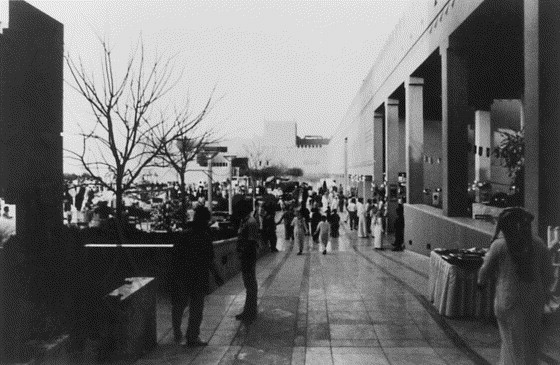 | Figure 3. DQ: Plaza source: (Al-Hathloul and Mughal 1999) |
Jacobs was the first to clarify the relationship among mixed land use, social interaction and sense of community. Choay (1965) Public housing complexes destroyed traditional mixed-use communities that produce a vibrant street life. Activities as a Tool for Implementation of the Public Realm A study done in Malaysia to promote social interaction between people of different backgrounds highlighted how government intervention would help contribute to a more cohesive society. Traditionally, a designed space can only create opportunities of interaction in a passive way. Studies show that there is need for other stimuli to create active interaction. The study looks into how proactively a public urban space can contribute to this issue. Urban public space is considered as a mixing point for different ethnic groups and architecture can play a role in social interaction (See Figure 4 below.)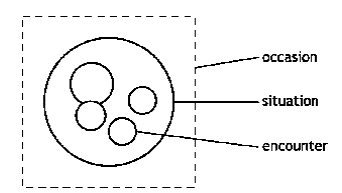 | Figure 4. The concept of Occasion, Situation and Encounter: source (Ludvigsen, 2006) |
If the social space can be considered as the ‘situation’ that provides the opportunity to gather, an ‘Occasion’ would be the activity that creates the situation and an ‘encounter’ would be a dynamic set of activities and mutual interactions that would be facilitated by the two.Goffman (1963) states that being present in a ‘space’ for an ‘occasion’ opens up an opportunity for ‘passive’ interaction which can generate dynamic activities even if people do not actually interact with each other. This includes stages of Co-presence at the first stage (where only gathering takes place and people may have their own focuses which are different from each other, a notion he labelled as ‘distributed attention’) and Co-attention at the next stage.ie, some event at the space that can draw everyone’s attention towards iteven though no one actually interacts with other people. This has been labelled as ‘shared attention’. This interaction could then escalate towards an ‘Active’ phase of interaction at which exchange and action can take place (Figure-5 & 6). | Figure 5. The two stages and four levels of social interaction. Hoay Nee, T., & Hayat Khan, D (British Journal of Arts and Social Sciences, Vol.8Noni (2012) |
 | Figure 6. Typical and new approach in zoning in public space. Hoay Nee, T., & Hayat Khan, D (British Journal of Arts and Social Sciences, Vol.8 No.II (2012) |
Our visual sense is the key to giving us the perception of the physical quality of a space (Albers, 2012). Dragging people to the space may be the first step, but once people are in that space the stimuli starts generating possibilities of passive interaction (co-presence and co-attention) as well as of active interaction (co-exchange and co-action). Interestingly, our visual sense plays a big role in group member detection as well.When place of residence is juxtaposed with shopping and recreational places, social interaction is facilitated because people are encouraged to roam around and move. The mixture of residential and commercial land uses increases opportunities for “chance encounters.” Spaces will be empty and unused if activities are not organized in these spacesA high-quality outdoor space can enhance social interaction by attracting people to come and stay for some time. The more time people spend outdoors, the more likely are they to engage in activities (Knack, 2000).Reducing vehicular traffic, creating a good mix of activities and establishing municipal events such as street festivals and exhibitions enhance the social interactions and create vitality for citizens.In summary, it is clear from literature that the built form, light, shade and quality of the outdoor environment act as factors contributing to the attraction of people to a public space. Governmental policies and intervention and promotion of public events such as concerts, and initiation of other activities generates interest that enhances the possibility of interaction between people thus bringing more life and vitality to the place.
3. Methodology
The research study focuses on the Pearl in Doha. The Pearl is the only man-made island developed in Qatar, which will be followed by other similar developments in Qatar in the next future. The aim of the research study is investigate the extent to which the urban design of this landmark project is successful in enhancing social interactions and liveability. In turn, the findings will allow defining design principles for the improvement of liveability within future man-made developments.The overall design of the project will take a qualitative approach, meaning use of a formal, objective and systematic process where data are utilized to test the following research questions: Why is the place not attracting enough people? And how can the social interaction and liveability in the public space in the Pearl be enhanced? This was achieved by means of interviews and observation.
4. Data Collection
Data was collected through site investigation, photo graphs and relevant visual material as well as semi-structured and open-ended interviews with visitors, residents, and owners. The cohort for this research was chosen as available during the authors’ visit timings – one on the weekend, in the morning and once during the night of the second day of Eid Al Adha 2015. The sample population (50 persons aged between 25 and 55) responding to semi-structured and open-ended questions were of mixed nationalities: almost half of them were local citizens and the other half were expatriates. An approximate equal number of male and female respondents were chosen in both categories. Among the expatriates, half were Western and half were Asians and Arabs. They all worked in highly paid jobs and spent time with family or friends in the Pearl. Only about 15 respondents from the surveyed population lived in the Pearl. Others lived in apartments and villas located elsewhere in the cityor were tourists. The questions were categorised into (A) general questions, mainly about provenience, nationality and social status, (B) semi-structured questions about the users’ exp erience at the Pearl, and finally (C) open-ended questions where respondents were free to highlight and discuss their views and opinions about liveability issues related to the Pearl. The results were generated using statistical analysis.From the data collected from the interviews and visual material and namely from the analysis of perspectives, experiences and responses gleaned relating to the extentto which liveability can be enhanced in the Pearl, it emerged that thebuilt environment should be strategically implemented accordingly to specific categories, which will be defined in the following section.
5. Findings
Visual data shows us that during the night of Eid, it was nearly impossible to walk or cross the roads due to the enormous number of monstrous vehicles that filled the place. It seemed as if one were on the busy roads of Qatar. If vehicle access is not curbed, people will be discouraged from using the space. Site investigation included user satisfaction data about the public spaces at the Pearl which revealed that requirements of families are different from that of bachelors. About 80% of expatriates who visited the site with families highlighted their preference for having more green areas, walking paths and safe kids’ playgrounds. 65% of respondents were Arabsbachelors who looked for more active places like cinemas. Asian and Western expatriates were more interested in cycling lanes. Another predominant finding was that 75% of the interviewed cohort prefers to visit the Pearl during the night rather than morning and when this aspect was queried, respondents complained that they didn’t find a lot of shaded areas in the morning. 90% of the respondents highlighted that high temperatures throughout most parts of the year, combined with the lack of shading in the open walkways, as well as the lack of festivals and events were the key factors that discouraged people from using this well designed space.Most Families also emphasised that unrestricted vehicular access to the areas of the restaurants etc seemed risky for children to be left free, and hence parents prefer not to let their kids move around unsupervised on bicycles etc.At the socio cultural level, the study revealed that users had some issues with identifying with the place. This was mostly true in cases of local families rather than expatriates. Some people felt that the clothing worn by western nationals was unsuitable in public places, and that they had difficulty accepting it in an Islamic society. Furthermore some restaurants served wine in their menus which is completely forbidden in the Islamic Religion, along with the use of “non-Halal” elements in some cuisines. This emphasises the point that businesses and owners of public places need to be sensitive towards the local identity and culture of the residents here. The existing condition has to improve and this was also highlighted by polls in local newspapers. Furthermore, visitors in the Pearl also need to respect the historical background of local people and help in preserving their identity. Literature reviews done for this study also indicated that more in-depth roles must be played by governmental sectors and various agencies to enhance public awareness and participation in supporting this vision.With regards to the physical aspects of the built form, the study examined the existing conditions of streetscapes, pedestrian circulation, parking area locations, landscaping details etc. to enhance livability and walkability. The luxury vehicle dealerships and personalised jewellers and the lifestyle in the Pearl provides a fine setting. Visually, as well as in terms of thermal comfort, the pathways that act as a connecting space between the buildings and outdoor areas aren’t well shaded. The sparse landscaping and shading make it difficult for one to be comfortable except if the weather outside is pleasantly cool. As per the data received from participants, users also indicated that they prefer to park far away and walk or cycle around if vehicular access would be curbed in the public open spaces by the management. This would ensure better pedestrian connectivity and safety between cafes, restaurants and apartments. Such a measure would encourage more people of all ages to freely move about and enjoy the cafés and restaurants while looking at the spectacular views of the sea. The data collected enables us to develop strategies for how the public spaces in the pearl can be optimised to serve our goal. Figures 7-10 in the appendices show pictures taken on the night of Eid Ul Adha 2015 while pictures 11-18 show the underutilized spaces in the day time.
6. Conclusions and Discussions
Activities, events, festivals and exhibitions play an important role in creating an interesting atmosphere for users. The case study of Malaysia discussed in the literature review showed how governmental role has a positive influence on revitalization of the site. This might be implemented within the Pearl, where policies might be enhanced to create spaces utilized for social activities. Interactions amongst the visitors and residents of various backgrounds and cultures are encouraged by diverse multi use places (entertainment, commercial, amenities and housing) that are capable of attracting more people to their environments. Mixed land use, social interaction and sense of community produce a vibrant street life as seen in the case study of the Diplomatic Quarters in Riyadh. The design guidelines adopted for the development of this landmark in Riyad might be implemented, accordingly with the findings related to the Pearl. Based on the study conducted at the Pearl, some key aspects that need to be addressed are highlighted below. The following are the identified measures suggested to enhance liveability within the Pearl.Ÿ Convert streets into pedestrian thoroughfares Gradually add more pedestrian-only streets, linking them to pedestrian-priority streets, where walkers and cyclists have right-of-way but cars are allowed to travel only at low speeds. Reduce traffic and parking gradually.Reduce the number of cars in the commercial areas by eliminating parking spaces or placing them on the outskirts.Ÿ Keep scale dense and lowLow-rise, densely spaced buildings allow breezes to pass over them making the ambient temperature cooler. Shading devices between buildings as well as providing more tall shaded trees would also add to comfort.Ÿ Respect the human scaleMake walking a pleasant experience by providing more shaded walkways, awnings, and doorways that give people impromptu places to stand and sit.Ÿ Populate the coreRather than having residential areas and commercial activities segregated, mixed use gives visiting pedestrians as well as residents a feeling of safety and active presence, day and night, and animates the area.Ÿ Adapt the cityscape to changing seasonsOutdoor cafes, public squares and street performers attract thousands in the summer; thermally controlled benches (which don’t absorb heat), shading and air blowers or fans on street corners make summers in the outdoor area more bearable.Ÿ Promote walking, buggies and cycling as the main modes of movement.Measures should also be undertaken to improve walk ability, cycling and safety. Safe forms of transport restricted to special lanes, such as cycling, battery operated cars and buggies (operated by the management) would encourage children as well as adults to walk more freely in the other spaces. Bike and buggy crossings at intersections would also help. Bicycles should be made readily available, to allow anyone to rent a bike from stands around the Pearl for a small coin deposit. When finished, they could simply leave them at any one of the bike stands located around the development and their money be refunded.Ÿ SignageAppropriate signage, pavement markings and street lights would help avoid confusion and add to safety.Ÿ The outdoors should be made more comfortableThermal comfort can be ensured by providing walkways that are shaded adequately, probably even having fans or blowers that would cool the ambient air. Shading devices should be installed along walking areas of the waterways and areas outside the restaurants, as well as tall leafy trees of various types, that can modify the microclimate and create interest in the walkways. The overall appearance and cleanliness should be maintained as this would add to comfort levels.New street furniture, lighting in convenient and comfortable locations would attract more people to stay outdoors longer, taking into account the location of shops and amenities, Open space development needs to attract people. Correct understanding of socio-cultural requirements is an important factor in the success of the open public space. Public authorities, organisations, and businesses should focus on attracting people, through a variety of activities and services, which add life and soul to the place, through organising activities for all ages, especially for children; and for different cultures, including sporting, entertainment and cultural events, festivals and exhibitionsIn conclusion this research study highlights that, accordingly to the users of the public spaces within the Pearl, which was conceived as a world-class facilities provider, interventions are required to be made in order to implement liveability of its open public spaces. Open public spaces need to not just be designed well but also need interventions such as organization of events and festivals, concerts etc to attract more people and encourage interactions between them. The recommendations made in this paper highlight how public spaces could be revitalized at the Pearl, thus encouraging greater, more enjoyable, and more varied interactions between people of various ages and cultures. It would also benefit people’s health through encouraging physical activity in the car-free safety, fresh air and sunshine. It would as a result yield a better quality of life, and become a more liveable and socially sustainable development. The results of this study can help planners and designers to revitalize the public areas of the Pearl. Further research could be done later on to measure the users’ satisfaction from the improved public spaces at the Pearl.
Appendices
 | Figure 7. Cars have the majority at the space, source: the author |
 | Figure 8. Shaded areas are limited within the space, source: the author |
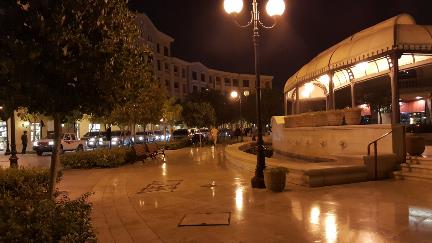 | Figure 9. Modern Landscaping, source: the author |
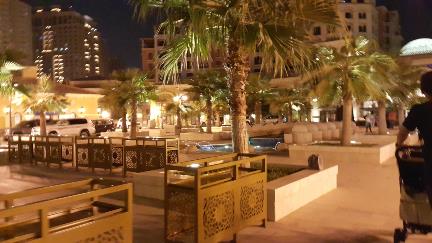 | Figure 10. Vacant Public spaces, source: the author |
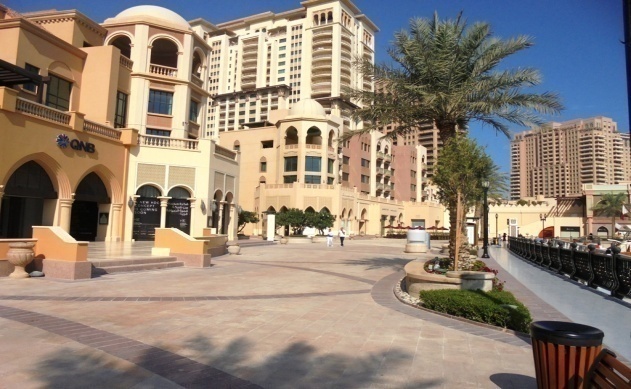 | Figure 11. Barren open space without any shading, source: the author |
 | Figure 12. Absence of adequate canopies for Café seating, source: the author |
 | Figure 13. Directly exposed to the sun and thus lacking users, the author |
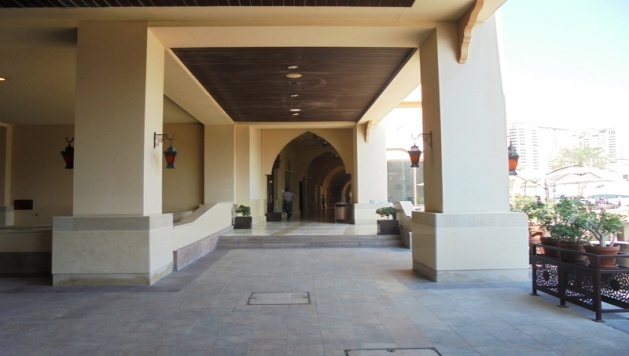 | Figure 14. Covered areas within the buildings: the author |
References
| [1] | Social Differences In The Arab Culture - Arab Business Etiquette. (N.D.). Retrieved October 7, 2015. |
| [2] | Farida, N. (2013). Effects Of Outdoor Shared Spaces On Social Interaction In A Housing Estate In Algeria. Frontiers Of Architectural Research, 457-467. |
| [3] | Ali Akbari, M. (29). The Impact Of Social Interactions In Urban Spaces Through Approach Of Improving Urban Vitality: A Case Study In Julfa District Of Isfahan. In *Msc In Architecture. Bam, Iran: Young Researcher Club, Bam Branch, Islamic Azad University, Bam, Iran. |
| [4] | Hoay Nee, T., & Hayat Khan, D. (N.D.). Revisiting Strategies To Enhance Social Interaction In Urban Public Spaces In The Context Of Malaysia. British Journal Of Arts And Social Sciences,Vol.8 No.Ii (2012), 199-212. Doi:Issn: 2046-9578. |
| [5] | Shin, Y. J. (2009). Understanding Spatial Differentiation Of Social Interaction: Suggesting A Conceptual Framework For Spatial Mediation. Communication Theory.Doi:10.1111/J.1468-2885.2009.01350.X. |
| [6] | Haas, T., And K. Olsson. "Transmutation And Reinvention Of Public Spaces Through Ideals Of Urban Planning And Design." Space And Culture 17.1 (2013): 59-68. Web. |
| [7] | Gough, M. Z. "Reconciling Liveability And Sustainability: Conceptual And Practical Implications For Planning." Journal Of Planning Education And Research 35.2 (2015): 145-60. Web. |
| [8] | Al-Hathloul, Saleh, And Muhammad Aslam Mughal. "Creating Identity In New Communities: Case Studies From Saudi Arabia." Landscape And Urban Planning 44.4 (1999): 199-218. Web. |
| [9] | Furlan R (2015) Liveability And Social Capital In West Bay, The New Business Precinct Of Doha. Arts Social Sci J 6:116. Doi:10.4172/2151-6200.1000116 10-(N.D.). Retrieved November 13, 2015, From Http://Www.Thepearlqatar.Com. |
| [10] | Furlan, Raffaello & Faggion, Laura. (2015). The Development Of Vital Precincts In Doha: Urban Regeneration And Socio-Cultural Factors. American Journal Of Environmental Engineering, 5(4), 120-129. |
| [11] | Balsas, C. (N.D.). City Center Revitalization In Portugal. Cities, 19-31. 13-Http://Www.Pps.Org/Blog/Creating-Great-Streets-What-Does-It-Take-An-Interview-With-John-Massengale-Victor-Dover/. |
| [12] | New Urbanism, Public Space And Spatial Justice In Johannesburg: The Case Of 44 Stanley Ave. (N.D.). Retrieved November 13, 2015, From Http://Www.Cairn.Info/Revue-Annales-De-Geographie-2009-1-Page-76.Htm. |
| [13] | Pedestrian Cities. (N.D.). Retrieved November 13, 2015, From Http://Www.Newurbanism.Org/Pedestrian.Html. |
| [14] | Petruccioli A (2007) After Amnesia-Learning From The Islamic Mediterranean Urban Fabric. Altamura Bari Grafica & Stampa, Italy. |
| [15] | Farr, D. (2008). Sustainable Urbanism - Urban Design With Nature. United States: Wiley. |
| [16] | Brown, Lance Jay, Dixon, David, & Gillham, Oliver. (2014). Urban Design For An Urban Century-Shaping More Liveable, Equitable, And Resilient Cities. New Jersey, Usa: John Wiley & Sons. |
| [17] | Daher, R. (2010). Architecture And Urbanism In The Middle East. In T. M. E. Institute (Ed.), Http://Www.Mideasti.Org. |
| [18] | Ankerl G (1981) Experimental Sociology Of Architecture: A Guide To Theory, Research And Literature. Mouton De Gruyter-The Hague, Paris, New York. |
| [19] | Wheeler, Stephen. 2013. Planning For Sustainability: Creating Liveable, Equitable And Ecological Communities. New York: Routledge. |
| [20] | Sommer R (1983) Social Design: Creating Buildings With People In Mind. Englewood Cliffs, Prentice-Hall, New Jersey. |
| [21] | General Information About Qatar. (N.D.). Retrieved November 13, 2015, FromHttp://Www.Qsa.Gov.Qa/Qatarcensus/Generalinfo.Aspx (N.D.). Retrieved November 13, 2015, From Http://Www.Gsdp.Gov.Qa/Portal/Page/Portal/Gsdp_Ar/Statistics_Ar/Statistical_Topics_Ar/Population_Ar. |
| [22] | Qatar's Population - By Nationality. (2013, December 18). Retrieved November 13, 2015, From Http://Www.Bq-Magazine.Com/Economy/2013/12/Population-Qatar. |
| [23] | Al Hathloul, S. 1996. The Arab- Muslim City. Tradition Continuity And Change In The Physical Environment, Dar Al Sahan, Riyadh. |

















 Abstract
Abstract Reference
Reference Full-Text PDF
Full-Text PDF Full-text HTML
Full-text HTML